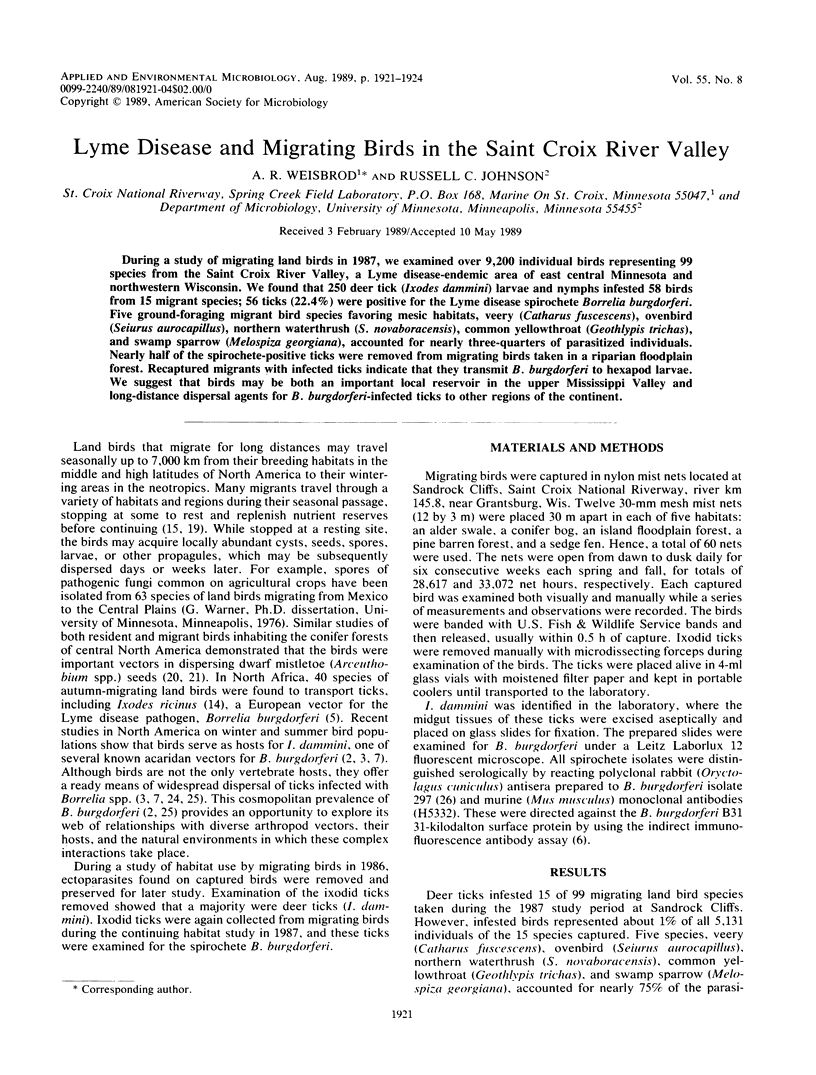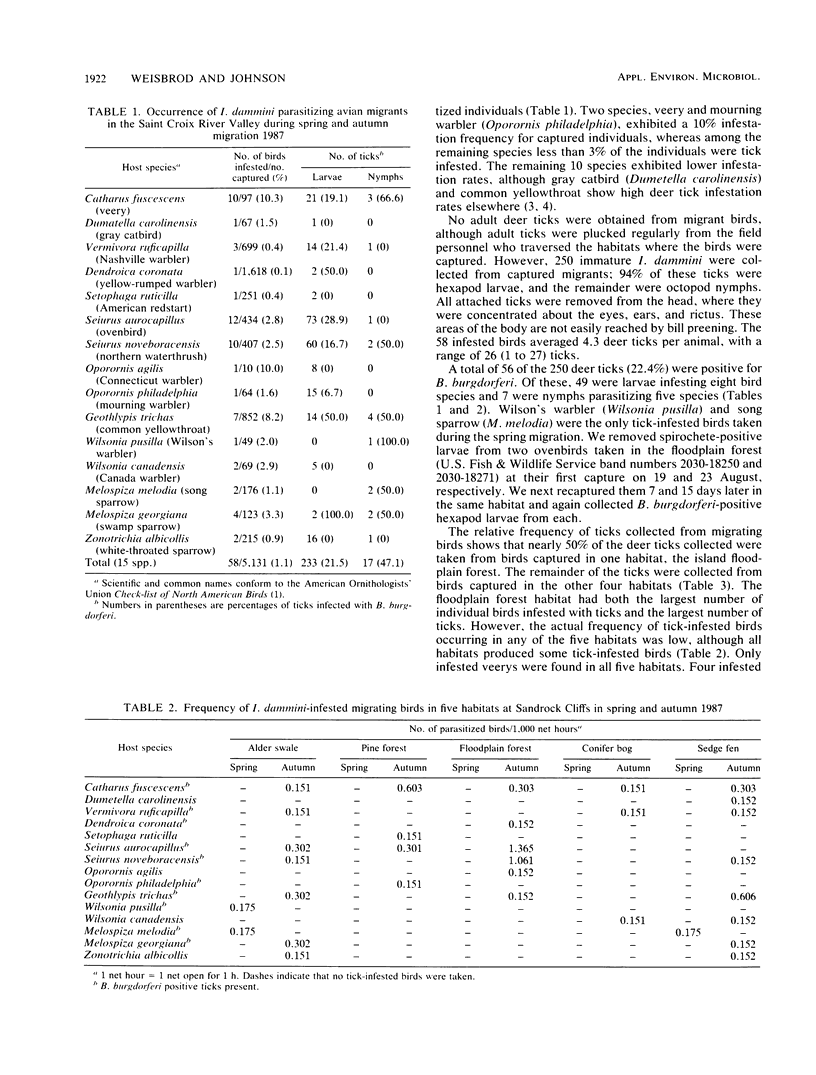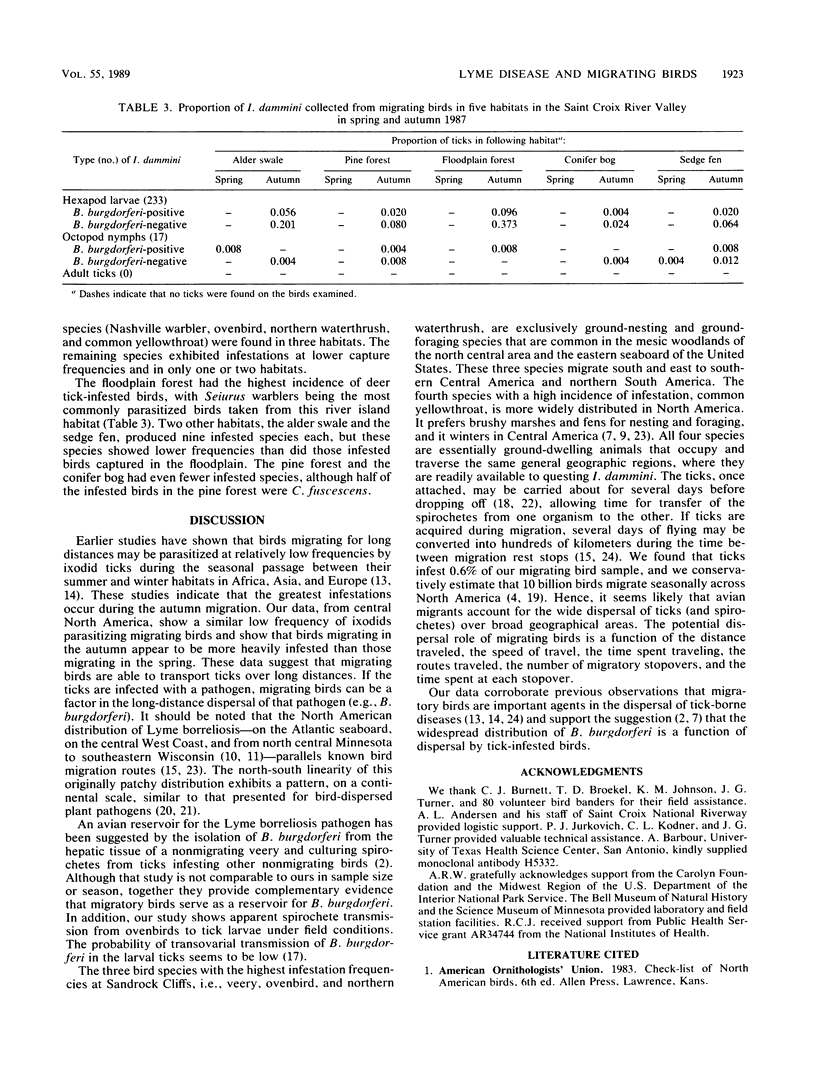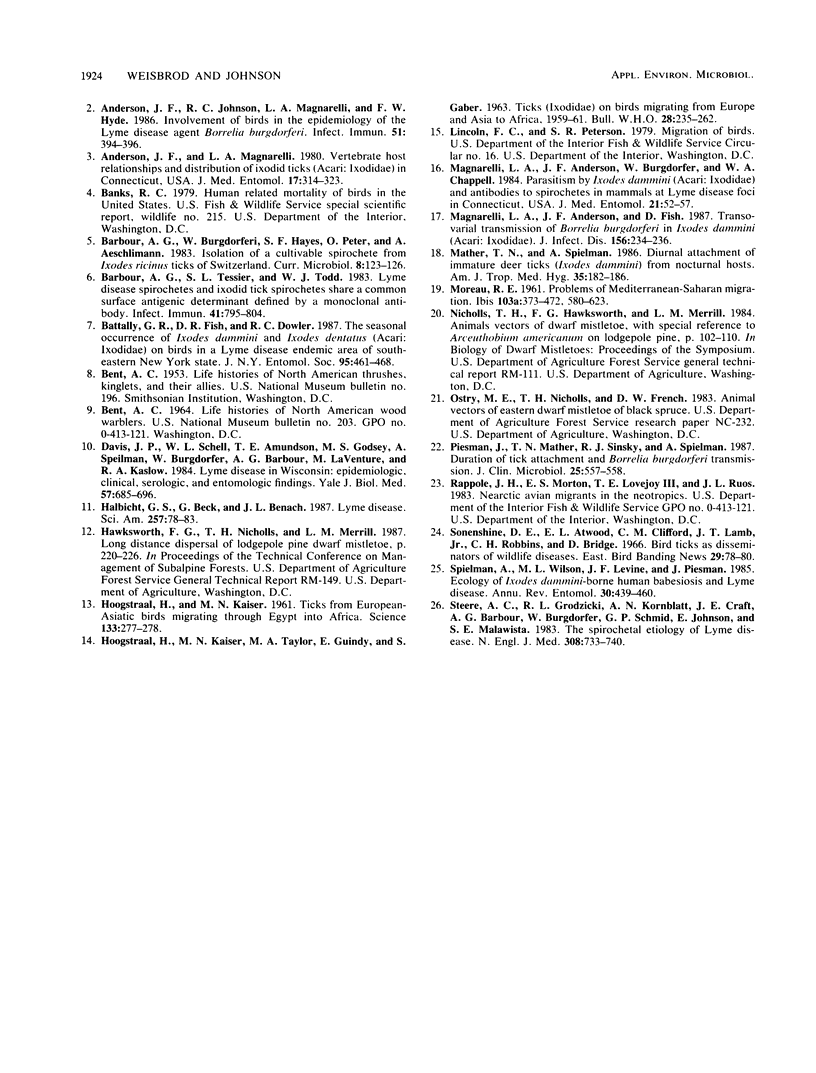Abstract
During a study of migrating land birds in 1987, we examined over 9,200 individual birds representing 99 species from the Saint Croix River Valley, a Lyme disease-endemic area of east central Minnesota and northwestern Wisconsin. We found that 250 deer tick (Ixodes dammini) larvae and nymphs infested 58 birds from 15 migrant species; 56 ticks (22.4%) were positive for the Lyme disease spirochete Borrelia burgdorferi. Five ground-foraging migrant bird species favoring mesic habitats, veery (Catharus fuscescens), ovenbird (Seiurus aurocapillus), northern waterthrush (S. novaboracensis), common yellowthroat (Geothlypis trichas), and swamp sparrow (Melospiza georgiana), accounted for nearly three-quarters of parasitized individuals. Nearly half of the spirochete-positive ticks were removed from migrating birds taken in a riparian floodplain forest. Recaptured migrants with infected ticks indicate that they transmit B. burgdorferi to hexapod larvae. We suggest that birds may be both an important local reservoir in the upper Mississippi Valley and long-distance dispersal agents for B. burgdorferi-infected ticks to other regions of the continent.
Full text
PDF



Selected References
These references are in PubMed. This may not be the complete list of references from this article.
- Anderson J. F., Johnson R. C., Magnarelli L. A., Hyde F. W. Involvement of birds in the epidemiology of the Lyme disease agent Borrelia burgdorferi. Infect Immun. 1986 Feb;51(2):394–396. doi: 10.1128/iai.51.2.394-396.1986. [DOI] [PMC free article] [PubMed] [Google Scholar]
- Anderson J. F., Magnarelli L. A. Vertebrate host relationships and distribution of ixodid ticks (Acari: Ixodidae) in Connecticut, USA. J Med Entomol. 1980 Jul 31;17(4):314–323. doi: 10.1093/jmedent/17.4.314. [DOI] [PubMed] [Google Scholar]
- Barbour A. G., Tessier S. L., Todd W. J. Lyme disease spirochetes and ixodid tick spirochetes share a common surface antigenic determinant defined by a monoclonal antibody. Infect Immun. 1983 Aug;41(2):795–804. doi: 10.1128/iai.41.2.795-804.1983. [DOI] [PMC free article] [PubMed] [Google Scholar]
- Davis J. P., Schell W. L., Amundson T. E., Godsey M. S., Jr, Spielman A., Burgdorfer W., Barbour A. G., LaVenture M., Kaslow R. A. Lyme disease in Wisconsin: epidemiologic, clinical, serologic, and entomologic findings. Yale J Biol Med. 1984 Jul-Aug;57(4):685–696. [PMC free article] [PubMed] [Google Scholar]
- HOOGSTRAAL H., KAISER M. N., TRAYLOR M. A., GUINDY E., GABER S. Ticks (Ixodidae) on birds migrating from Europe and Asia to Africa 1959-61. Bull World Health Organ. 1963;28(2):235–262. [PMC free article] [PubMed] [Google Scholar]
- HOOGSTRAAL H., KAISER M. N. Ticks from European-Asiatic birds migrating through Egypt into Africa. Science. 1961 Jan 27;133(3448):277–278. doi: 10.1126/science.133.3448.277. [DOI] [PubMed] [Google Scholar]
- Habicht G. S., Beck G., Benach J. L. Lyme disease. Sci Am. 1987 Jul;257(1):78–83. doi: 10.1038/scientificamerican0787-78. [DOI] [PubMed] [Google Scholar]
- Magnarelli L. A., Anderson J. F., Burgdorfer W., Chappell W. A. Parasitism by Ixodes dammini (Acari: Ixodidae) and antibodies to spirochetes in mammals at Lyme disease foci in Connecticut, USA. J Med Entomol. 1984 Jan 26;21(1):52–57. doi: 10.1093/jmedent/21.1.52. [DOI] [PubMed] [Google Scholar]
- Magnarelli L. A., Anderson J. F., Fish D. Transovarial transmission of Borrelia burgdorferi in Ixodes dammini (Acari:Ixodidae). J Infect Dis. 1987 Jul;156(1):234–236. doi: 10.1093/infdis/156.1.234. [DOI] [PubMed] [Google Scholar]
- Mather T. N., Spielman A. Diurnal detachment of immature deer ticks (Ixodes dammini) from nocturnal hosts. Am J Trop Med Hyg. 1986 Jan;35(1):182–186. doi: 10.4269/ajtmh.1986.35.182. [DOI] [PubMed] [Google Scholar]
- Piesman J., Mather T. N., Sinsky R. J., Spielman A. Duration of tick attachment and Borrelia burgdorferi transmission. J Clin Microbiol. 1987 Mar;25(3):557–558. doi: 10.1128/jcm.25.3.557-558.1987. [DOI] [PMC free article] [PubMed] [Google Scholar]
- Spielman A., Wilson M. L., Levine J. F., Piesman J. Ecology of Ixodes dammini-borne human babesiosis and Lyme disease. Annu Rev Entomol. 1985;30:439–460. doi: 10.1146/annurev.en.30.010185.002255. [DOI] [PubMed] [Google Scholar]
- Steere A. C., Grodzicki R. L., Kornblatt A. N., Craft J. E., Barbour A. G., Burgdorfer W., Schmid G. P., Johnson E., Malawista S. E. The spirochetal etiology of Lyme disease. N Engl J Med. 1983 Mar 31;308(13):733–740. doi: 10.1056/NEJM198303313081301. [DOI] [PubMed] [Google Scholar]


